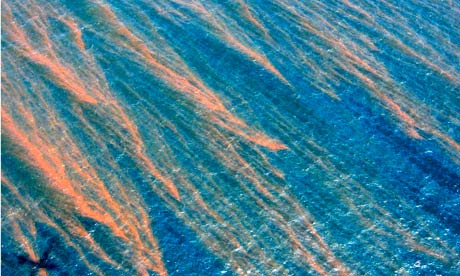• First oil washes ashore in Alabama
• BP engineers admit rethink is needed
• Failed 100-tonne tower lifted off the seabed

Oil is seen on the surface of the Gulf of Mexico as BP tries to stop oil leaking from the Deepwater Horizon wellhead in the Gulf of Mexico. (Reuters)
Hopes of a quick fix to stop oil from the Deepwater Horizon oil rig gushing into the Gulf of Mexico were dashed on Saturday, when a build-up of crystallised gas blocked the pipes in the huge metal containment tower, which then had to be lifted from the seabed.
While BP engineers wrestled with the problem, reports came in of the first tar balls and tar beads washing up on the white sand beaches of Dauphin Island, off Alabama.
The metal tower, specially designed and constructed to cap the leak, is the height of a four-storey building and weighs 100 tonnes. The hope was it would hold the oil still gushing out of the well, which could then be siphoned out of the top, but the blocked pipes made that impossible.
The chief operating officer, Doug Suttles, said: “I wouldn’t say it’s failed yet. What I would say is what we attempted to do last night didn’t work because these hydrates plugged up the top of the dome.”
He predicted that it could take another 48 hours to find a resolution.
The problem is blamed on methane gas, partly frozen into slush by the cold temperatures on the seabed at 1,500 metres (5,000ft). Engineers anticipated the problem, but not the volume of the gas build-up in the pipes. Suttles said that solutions could include heating the area, or adding methanol to break up the hydrates.
Meanwhile, oil continues gushing into the Gulf of Mexico at a rate of 4,000 barrels a day or more.
Teams were sent by BP to Dauphin Island to test the tar washing up on the beaches, to establish whether it really does come from the spill. They will also lay down clusters of oil-absorbing synthetic fibres, and build storm-fencing along the beach.
A spokesman for the spill response command said that tar washing ashore on Alabama’s beaches was common. However, local residents, holding up fist-sized chunks, said they had never seen anything like it before.
Construction workers have been racing around the clock, all weekend, to finish laying a three-mile boom across the mouth of Mobile Bay, Alabama, the ninth largest port in the US. The boom, tethered to a line of pilings driven into the sea bed, is being built with a double gate to allow ships to pass through. Vessels will be held between the gates, checked for oil contamination, and cleaned if necessary before being allowed to proceed. The bay is also home to beach resorts and commercial and leisure fisheries, including oyster beds.
Fishing restrictions mean thousands of boats have been tied up idle. Oyster processing plants are running out of supplies and shutting down, putting hundreds of people out of work.
Wayne Eldridge, owner of J&W Marine Enterprises, an oyster plant operator, said: “I’m screwed. The biggest thing is I’ve got 35 people unemployed there.”
Maev Kennedy and agencies
Sunday 9 May 2010 13.31 BST
Source: The Guardian
More information:
– US not accepting foreign help on oil spill
– Gulf of Mexico Oil Spill: New NOAA Projection Map; BP’s High-Stakes Mission; And More News